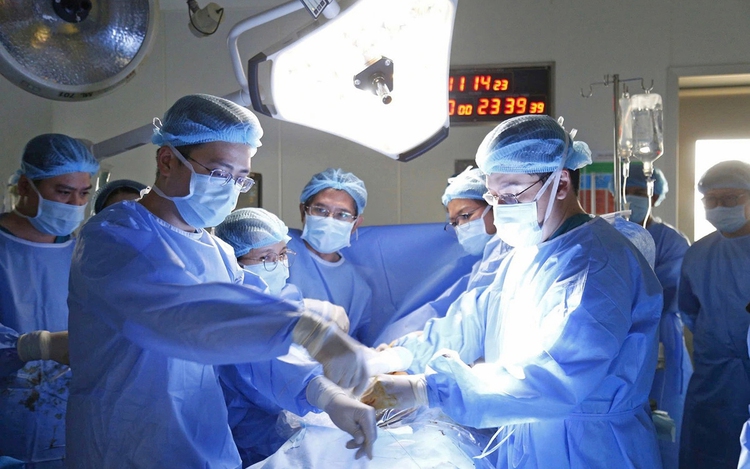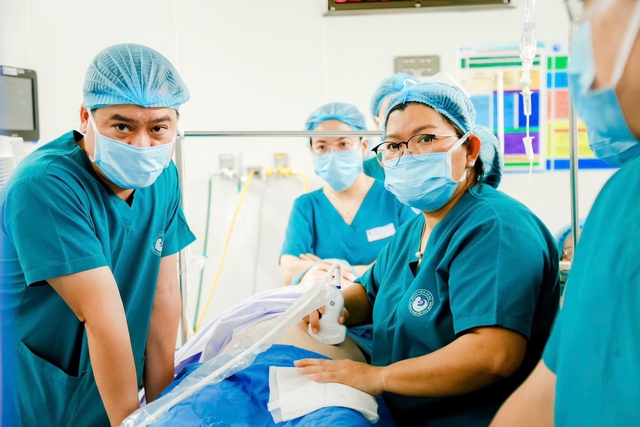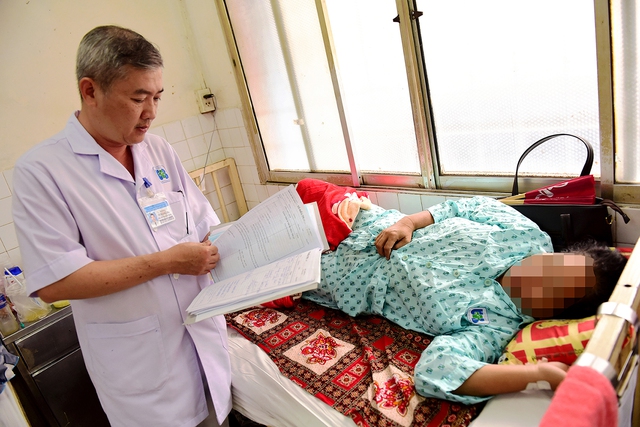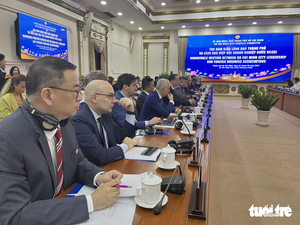
Doctors from Tu Du Hospital and Children’s Hospital 1 in Ho Chi Minh City perform a successful fetal cardiac intervention on a 41-year-old pregnant patient from Singapore. Photo courtesy of Tu Du Hospital.
According to the Ministry of Health, an estimated 300,000 foreigners travel to Vietnam annually for medical examinations and treatment.
Ho Chi Minh City alone accounts for over 40 percent of these visits, underscoring the city’s potential to become a regional medical tourism center.
In a recent case that gained regional attention, doctors from Children’s Hospital 1 and Tu Du Hospital in Ho Chi Minh City successfully performed a fetal cardiac catheterization on a pregnant Singaporean patient.
The rare procedure demonstrated Vietnam’s capability in advanced medical interventions.
Minister of Health Dao Hong Lan sent a commendation letter to the medical teams, stating that the success of the procedure strengthens Vietnam’s reputation in high-tech healthcare and fosters international trust.
Medical tourism in Vietnam has seen growing interest due to its relatively low treatment costs and skilled medical professionals.
In one instance, an Australian family living in Bali brought their four-year-old daughter to Saint Paul Hospital in Hanoi for minimally invasive bile duct cyst removal — a procedure successfully performed at only two centers globally.
The child recovered quickly with minimal scarring, and her family expressed high satisfaction with the outcome.
At Viet Duc University Hospital in Hanoi, a 30-year-old Vietnamese woman living in New Zealand underwent reconstructive surgery after three failed operations abroad.
The hospital has also treated patients from countries including Poland, Hungary, Japan, and the UK for complex colorectal and anal conditions.
Many foreign patients cite lower costs, competent doctors, and improving service quality as reasons for choosing Vietnam.
Major cities such as Ho Chi Minh City and Hanoi host several hospitals that meet international standards.

Doctors from Tu Du Hospital and Children’s Hospital 1 in Ho Chi Minh City perform a successful fetal cardiac intervention on a 41-year-old pregnant patient from Singapore. Photo courtesy of Tu Du Hospital.
Hospitals seek to capitalize on medical tourism potential
The rise in foreign patients has prompted hospitals to invest in infrastructure, staff training, and international cooperation.
Nguyen Thanh Tuyen, deputy director of the Traditional Medicine Institute in Ho Chi Minh City, said the institute has pursued medical tourism for the past three years.
While partnerships with tourism agencies remain limited, the institute primarily serves individual patients and sees potential in expanding cooperation with travel firms to meet diverse patient needs.
Vietnam’s top-tier hospitals are also developing specialized services for overseas Vietnamese and foreigners.
The Ho Chi Minh City Hospital of Dermatology and Venereology, for example, has launched aesthetic and dermatological care packages tailored to this clientele.
Director Nguyen Thi Phan Thuy said the hospital’s strength lies in the expertise of its specialists, who integrate modern medicine with advanced cosmetic technologies.
Meanwhile, 108 Military Central Hospital in Hanoi is expanding international research collaborations and training with institutions in over 40 countries.
Its leadership aims to make the hospital a trusted healthcare provider for both locals and foreigners living or working in Vietnam.
Strategic vision for growth
Ho Chi Minh City’s health department is implementing a government-approved plan to develop the city into a healthcare hub for ASEAN by 2030.
The strategy includes improving service quality and attracting international patients, in line with a broader national vision outlined in Politburo Resolution 31.
Officials have emphasized the importance of aligning Vietnam’s tourism and healthcare sectors.
Vu Nam, a tourism and hospitality expert at the National Economics University, said the country has both the natural resources and technical capacity to develop health and wellness tourism.
While spa, meditation, and herbal therapy-based tourism have gained popularity, clinical medical tourism — such as surgery or treatment for chronic illness — remains underdeveloped.
Vietnam already hosts a network of modern hospitals, especially in Hanoi and Ho Chi Minh City, and its doctors are considered on par with peers in developed countries.
In addition to Western medicine, the Southeast Asian country has strong potential in traditional medicine, such as acupuncture and herbal treatments.

A doctor examines a Cambodian patient at Ho Chi Minh City Oncology Hospital. Photo: Duyen Phan / Tuoi Tre
Challenges ahead
Despite the progress, challenges remain.
Many public hospitals face constraints in promoting medical tourism due to limited resources and regulatory hurdles.
Private hospitals and aesthetic clinics currently dominate the market for foreign patients.
Duong Huy Luong, deputy director of the Department of Medical Services Administration under the Ministry of Health, said Vietnamese patients spend an estimated US$2 billion annually on overseas medical treatment.
He emphasized the need to reverse this trend by improving domestic healthcare services.
The Ministry of Health is implementing a plan to attract foreign patients and high-income Vietnamese through high-quality services.
The proposal aims to develop a tiered system that serves both the general public and international patients, with a focus on infrastructure, digital transformation, skilled workforce development, and simplified administrative procedures.
Experts argue that in order for Vietnam to compete with regional leaders like Thailand or South Korea, a coordinated national strategy is required.
This includes identifying medical tourism zones, building internationally accredited facilities, and strengthening branding and promotion.
“Vietnam has the potential to become a leading medical and health tourism destination,” said Dr. Vu Nam.
“But to realize this, we need integrated efforts from the government, healthcare providers, and the tourism industry.”




Max: 1500 characters
There are no comments yet. Be the first to comment.